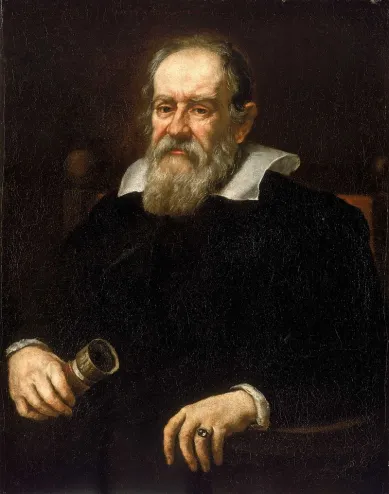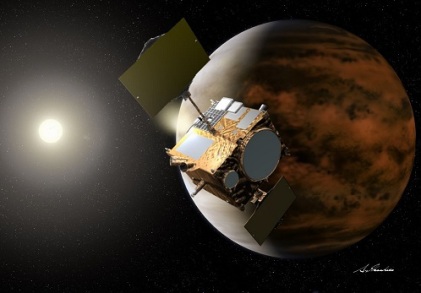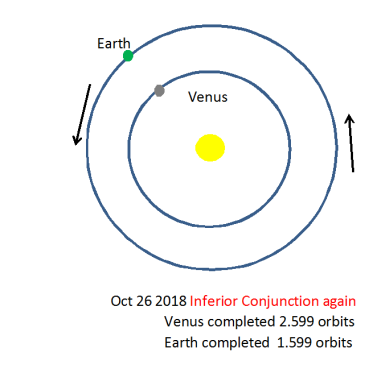Anybody who has looked up into the western sky after sunset in the past month will have noticed a brilliant white object – the planet Venus, sometimes called the Evening Star. It is brighter than any other planet and ten times brighter than the brightest star Sirius.
The “Evening Star” Venus next to the Moon just after sunset – image from NASA
There are three reasons why Venus is so bright. Firstly, it comes closer to the Earth than any other planet. Secondly, it is relatively large compared to other inner planets, roughly twice the diameter of Mars and three times that of Mercury. Although the giant planets – Jupiter, Saturn Uranus and Neptune – are larger than Venus, they are further away and so appear smaller. Thirdly, the thick clouds which completely cover Venus reflect most of the light back into space. In fact Venus reflects 77% of the sunlight hitting it, more than any other planet. Venus is so bright that it even possible to see it during daylight. If you know exactly where to look it appears as a faint white dot against the bright blue sky
Venus over the next two years
Venus is both closer to Sun and moves faster in its orbit than the Earth and, on average, it takes 584 days for Venus to be in the same place in its orbit as seen from the Earth. The reason for this 584 day cycle is given in the notes at the bottom of this post. Because the orbit of Venus is inside the Earth’s orbit, Venus can never appear too far away from the Sun in the sky. In general it is only clearly visible for at most a few hours before sunrise or a few hours after sunset (see note 2). The two points where Venus appears furthest away from the Sun are called the greatest elongation points and are marked as A and B in the diagram below.
Data from Espinak (2014)
Venus has just passed a greatest elongation point which it reached on 12 January 2017, and it is a brilliant object in the western sky, visible for at least 3 hours after sunset, depending on your latitude. Over the next few month as it gets closer to the Sun it will be visible for a shorter and shorter time after sunset. On 25 March Venus will pass between the Earth and the Sun. This is known as inferior conjunction, and for a few weeks or so either side of this date Venus will be very difficult to see because it will only be visible in daytime close to the Sun.
Looking the diagram above, you might think that Venus will pass directly in front of the Sun at inferior conjunction. However, this diagram only shows the picture in two dimensions. As shown below, because the orbit of Venus is tilted with respect to the Earth, at inferior conjunction it normally passes above or below the Sun.
Rarely at inferior conjunction Venus will pass directly in front of the Sun. When this occurs it is known as a transit of Venus.
A transit of Venus. Venus is the dark dot crossing the Sun’s surface – image from Wikimedia Commons
After inferior conjunction, it will appear to move away from the Sun and will rise and set earlier in the day and will start to become visible in the eastern sky before sunrise. At this point in its orbit Venus is known as the Morning Star. It will reach the other greatest elongation point on 3 June 2017, when it will be visible for least 3 hours before sunrise.
After reaching the greatest elongation, Venus will start to move closer to the Sun again. It will be visible for a shorter and shorter time before sunrise. On 9 January 2018 Venus will be directly behind the Sun. This is called superior conjunction and, for a few weeks or so either side of this date, Venus will be very difficult to see because it will only be visible in daytime and will appear close to the Sun. After superior conjunction Venus will appear in the evening sky after sunset and as it gets further from the Sun it will be visible for longer and longer before the Sun sets
On 17 August 2018 Venus will reach the greatest elongation point it had previously reached on 12 January 2017 and once again it will be visible for at least 3 hours after sunset as a brilliant object in the western sky.
Venus’s phases during the 584 day cycle
As seen from the Earth over the 584 day cycle, Venus goes through a full set of phases in a similar way to the Moon. However, because Venus appears so small, these are only visible through a telescope.
At inferior conjunction, point A in the diagram above, when Venus is between the Earth and the Sun, the sunlit part of Venus faces away from us making the planet almost invisible. The amount of the sunlit part of Venus we can see gets larger or waxes through to a crescent phase (B), to a half Venus (C) at the greatest elongation and then to a full Venus at superior conjunction (D), when the whole sunlit side facing the Earth is illuminated. It then gets smaller or wanes back to a half Venus (E) at greatest elongation, then to a crescent (F) and then finally back to being almost invisible at inferior conjunction
Galileo’s discovery
The first person to discover the phases of Venus was the Italian astronomer Galileo Galilei (1564-1642).
Image from Wikimedia Commons
In 1543, just before his death, Nicolas Copernicus (1473-1543) had published the theory of heliocentrism which was completely revolutionary in its day – that the planets orbit the Sun. However, in Gallileo’s time, the teaching of the Catholic church favoured geocentrism, the widely held view that the Earth was the centre of the Universe and the stars, planets, the Sun and the Moon were in orbit around it. Indeed certain verses of the bible could be interpreted as supporting that viewpoint, such as Psalm 104:5 “the Lord set the earth on its foundations; it can never be moved.”
However, the phases of Venus and the way that it appears smaller when it is a full Venus can only be fully explained by Venus orbiting the Sun, not the Earth. Therefore, Galileo concluded that the geocentric theory was incorrect. Unfortunately for Galileo, in 1616 the Catholic church declared heliocentrism to be heresy. Heliocentric books were banned and Galileo was ordered to refrain from holding, teaching or defending heliocentric ideas.
Despite this ruling Galileo continued to defend heliocentrism, and in 1633 the Roman Inquisition found him “vehemently suspect of heresy”, sentencing him to indefinite imprisonment. Galileo was kept under house arrest until his death in 1642.
However the facts cannot be disputed. When viewed through a telescope Venus does show changes in size and shape, which can only be satisfactorily explained in a heliocentric model. Eventually, in 1758, the Catholic Church dropped the general prohibition of books advocating heliocentrism.
And finally….
I hope you have you have enjoyed this post. In 2015 and 2016 I published a series of posts on Venus. Some of them are listed below.
Venus a Mysterious world describes Venus in science fiction and compares it these depictions of the planet to reality.
Akatsuki – a second chance describes the mission of the Japanese spacecraft Akatsuki which is currently in orbit around Venus studying its weather. The spacecraft should have gone into orbit in 2010. This didn’t happen but mission control were able to successfully put the spacecraft in hibernation for 5 years before making another successful attempt.
Terraforming Venus describes how in the future we could alter Venus to make it more Earth-like so that we could live on the planet without needing any special protective equipment.
Notes
(1) The diagrams below illustrate why it takes 584 days for Venus to be in the same position in its orbit in relation to the Earth. Venus and the Earth in their orbits around the Sun are like two runners on a track. The Earth takes 365.256 to do one circuit, whereas Venus, whose orbit is inside the Earth and moves faster around the Sun, only takes 224.701 days to do one circuit.
The point in time when Venus is closest to the Earth and lies between the Earth and the Sun is called inferior conjunction. The time interval between one inferior conjunction and the next is the time it takes for Venus to ‘gain a lap’ in its orbit around the Sun. This is shown in the diagrams below.
After approximately 580 days Venus and the Earth line up again.
In fact, because the Earth’s and Venus’s speed in their individual orbits aren’t constant but varies slightly, the interval between one inferior conjunction and the next also varies between 580 and 588 days.
(2) Strictly speaking, this depends on the latitude of the observer. Venus is visible for much longer at higher latitudes.
Update 22 November 2020
There is now a video on the Explaining Science YouTube Channel which describes Venus’s orbit and phases. To view it, please click on the link below
References
Espenak, F (2014) 2017 calendar of astronomical events, Available at: http://www.astropixels.com/ephemeris/astrocal/astrocal2017gmt.html (Accessed: 6 January 2017).














Hello. I am working on a story set in November and December of 7BC. Question: How do I find out, if Venus was a ”Morning star“ or an ”Evening star“ in that period? Any answers? Thank you.
LikeLike
I would use the Stellarium software which can be downloaded for free from stellarium.org
The following guide tells you how to enter negative dates
Click to access Stellarium.pdf
Essentially what you need to do is, for example enter a year of “-7” for a year of 7 BCE
LikeLike
Thank you so much for your response again.
I live in Shiraz (west part of Iran) . Every day a shining star is observed before sun set in the western sky ,and also a shining star before sunrise in the eastern sky.
If it might be possible, tell me the names of these stars .
LikeLike
Thank you so much for your useful infomation about the Venus ,I want to know , where in the diagram of Data from Espinak 2014 , Venus appears twice during a day and when only one time for example morning or evening
LikeLike
I am not sure what you mean.
All visible astronomical objects (including Venus): rise in the east, are above the horizon for a period of time and then set in the west.
Some (or all) of the time an object is above the horizon may be during the day (which makes it difficult or impossible to see because of the brightness of the daytime sky)
LikeLike
Thank you for your response,
I mean , Is it possible to observe the Venus only one time during 24 hours ?
In my previous question ,”during a day” means 24 hours.
LikeLike
Venus can only be easily seen when the sky is relatively dark after the Sun has set or before it has risen.
As discussed in the post, depending on Venus’s position with respect to the Earth, it can sometimes appear as the morning star before the Sun has risen, sometimes appear as the evening star after the Sun has set, but not both!!!
LikeLike
Thank you sir .
LikeLike
Venus was the first planet I learnt to identify as a child – probably the easiest one to spot without a telescope. 🙂
LikeLiked by 1 person
Hello SG
I am a avid stargazer and I believe we had the conversation about the Evening Star and the Morning Star being one and the same. Aw I see it in another one of your most informative post. This star has always been the one I wish on. I always wish for LOVE and what other planet is most fitting for that? Thanks again for an informative article/blog post. Tell the Mrs. Helooooo and Happy New Year!
TTYL ,
Lexa (aka in 2017) Goddess Phenomenon
LikeLike
Thank you for your kind comment.
hope you have a great 2017 !
LikeLike
I think I’ll settle for being an earthling, happy to see Venus from a distance. You might like to see the Vatican Observatory blog which includes all manner of astronomical information and thinking. But thank you for your kind comment on Agnellusmirror.wordpress.com with our take on the Evening Star, ‘Star of Wonder’. Phase was visible from Canterbury England, but then we are favoured with more clear skies than Manchester!
Will.
LikeLike
Very interesting.
LikeLiked by 1 person
There have been one or two incredibly clear nights here when the view of the Moon and Venus is a real wonder!
LikeLike
Sadly none for me in cloudy Manchester !
LikeLike